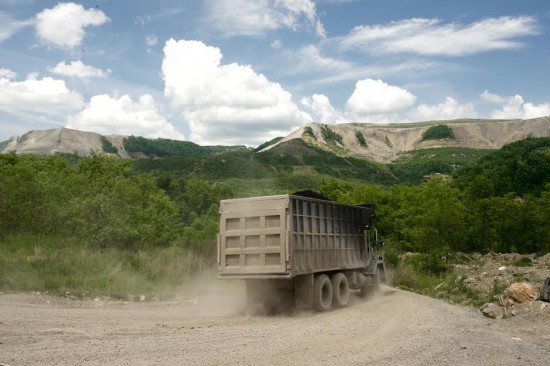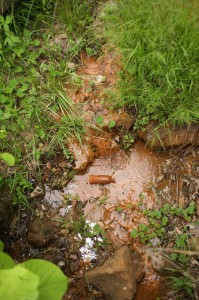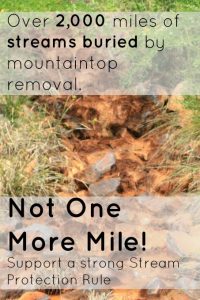Front Porch Blog
In July, the federal Office of Surface Mining Reclamation and Enforcement issued a long-awaited draft Stream Protection Rule. While it’s far from perfect, the proposed rule is a long-overdue update to protections for both surface and groundwater from mountaintop removal coal mining. It also provides much-needed clarification regarding a host of other issues, including reclamation standards and bonding requirements.
Not surprisingly, the industry is fighting the Stream Protection Rule tooth and nail. Instead of focusing on the substance of the rule though, opponents’ rely on tired “war on coal” talking points. The industry also argues these regulations are unnecessary and will undermine an otherwise viable industry — even though several large coal companies have declared bankruptcy. Let’s examine those claims.
First, this new rule was developed to update the rule currently in use — the 1983 Stream Buffer Zone rule — based on new science and realities on the ground. The past 32 years have provided ample time for additional research to prove what many Central Appalachian residents already know: that burying streams with mining waste permanently damages waterways and that mountaintop removal is linked to a host of other environmental and health problems. The Stream Protection Rule aims to address a number of current problems.
The Stream Protection Rule aims to improve methods for monitoring for and preventing damage to surface and groundwater. It’s important to note that the rule still allows for mining activities, including waste disposal, in streams. The new rule is actually weaker than the 1983 rule in this regard. The ‘83 rule prohibited mining disturbances within 100 feet of streams and prohibited damage to streams by mountaintop removal mining. In practice, however, states routinely grant variances to the ‘83 Stream Buffer Zone rule, allowing valley fill construction and other mining impacts to streams on a regular basis. This is often done by allowing companies to remediate other areas of streams that have already been degraded as a substitution for the stream miles they will bury or otherwise damage.
While it does not include a stream buffer zone requirement, the Stream Protection Rule does provide a number of added benefits for aquatic resources. New requirements include enhanced baseline monitoring data for both surface and groundwater. The availability of such data will make it easier to identify damage caused by mining. Under existing regulations, coal companies too often escape liability for damage to waterways because there is no baseline data to prove pollutants were not present before mining began. The draft rule also includes a definition of “material damage to the hydrologic balance”, which was never previously defined. Clarifying language like this is an important part of making sure that rules are enforceable on the ground.
An important question to ask is whether this type of regulation is necessary. In this case, the additional safeguards for streams are clearly needed. Research over the past decade has identified and quantified a number of critical issues with surface mining in Appalachia. A recent study examined coal companies’ success in restoring or recreating streams as a form of “trade” for other streams damaged or buried during mining. The study found that 97 percent of these projects failed optimal habitat scores for aquatic life. This is strong indication that rebuilding a stream’s form will not necessarily restore its function. Additionally, the study found that a majority of these restoration projects were completed in perennial streams, while mining damage was mostly occurring in intermittent and ephemeral streams. This is important because intermittent and ephemeral streams often provide unique habitat and food resources critical to the survival of many species.

Surface mining contributes to global warming through deforestation. If mining continues at recent rates, Central Appalachian forests will switch from being a net carbon sink to a carbon source by 2035.
The science clearly indicates the need for more protection of streams and other environmental resources, but would the cost of these protections be justifiable? Do the benefits to streams — and people, and tourism, and recreation, and … — outweigh the impact that the rule may have on the industry? The industry would like you to believe that this new rule will be so costly that it will create an unwarranted burden on an otherwise beneficial Central Appalachian industry. The OSMRE attempted to answer this debate through an Environmental Impact Statement (EIS), which includes cost-benefit analyses. In most scenarios, the OSMRE expects minimal job loss due to the new rule, in part due to jobs created through the need to comply with the rule.
What the EIS doesn’t adequately do is take into consideration the larger context of surface mining in Appalachia and the impacts it has on local communities. First, the coal industry already has a net negative impact on the economies of the states where it occurs. Several different studies in West Virginia, Virginia and Kentucky indicate this. In 2006, the coal industry cost the state of Kentucky $115 million. In 2009, the coal industry was estimated to cost the state of West Virginia $97.5 million and the state of Virginia $21.9 million.

Research over the last decade has identified and quantified a number of critical issues with surface mining in Appalachia. Additional safeguards for streams are clearly needed.
The EIS also does not consider surface mining’s global impact. The burning of coal in power plants releases carbon dioxide into the atmosphere, contributing to climate change. Surface mining in Central Appalachia also exacerbates climate change through deforestation. If mining continues at recent rates, forests in the region will switch from being a net carbon sink to a carbon source by the year 2035. This is due both to deforestation during the mining process and grassland reclamation. The Stream Protection Rule improves reclamation requirements so that more mined lands are returned to native forests, instead of the now-prevalent grasslands.
Lastly, the EIS does not consider the negative health outcomes associated with mountaintop removal. The prevalence of health problems the region is well documented. Most recently, a study showed that dust from surface mines can promote the growth of lung tumors. The negative impacts to the health of communities near mines alone should be enough to justify an end to mountaintop removal.
It is true that the coal industry in Central Appalachia is facing a particularly difficult time. Unlike previous boom and bust cycles, this downturn looks to be permanent. This is exactly why additional safeguards are necessary to protect public water. Companies desperate to turn a profit in a more competitive energy market may be more inclined to bend rules or ignore regulations all together. This time marks a critical and exciting opportunity to address economic diversification throughout the region. Protecting the communities and the natural assets of the region will be integral to a successful transition.
Stay informed by subscribing to The Front Porch Blog.
PREVIOUS
NEXT

Leave a comment
Your email address will not be published. Required fields are marked *


Leave a Comment